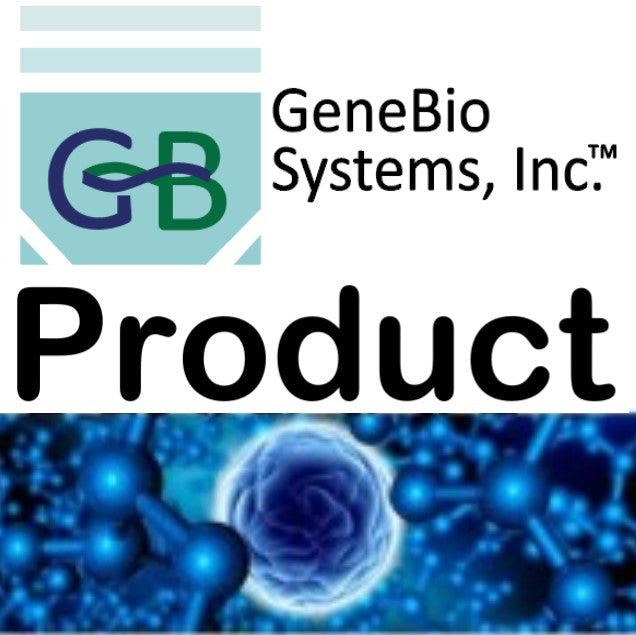Gene Bio Systems
Recombinant Human UDP-N-acetylglucosamine--peptide N-acetylglucosaminyltransferase 110KDA subunit(OGT),partial
Recombinant Human UDP-N-acetylglucosamine--peptide N-acetylglucosaminyltransferase 110KDA subunit(OGT),partial
SKU:CSB-EP016315HU
Couldn't load pickup availability
Size: 200ug. Other sizes are also available. Please Inquire.
In Stock: No
Lead time: 10-20 working days
Research Topic: Neuroscience
Uniprot ID: O15294
Gene Names: OGT
Organism: Homo sapiens (Human)
AA Sequence: MAEANHFIDLSQIPCNGKAADRIHQDGIHILVNMNGYTKGARNELFALRPAPIQAMWLGYPGTSGALFMDYIITDQETSPAEVAEQYSEKLAYMPHTFFIGDHANMFPHLKKKAVIDFKSNGHIYDNRIVLNGIDLKAFLDSLPDVKIVKMKCPDGGDNADSSNTALNMPVIPMNTIAEAVIEMINRGQIQITINGFSISNGLATTQINNKAATGEEVPRTIIVTTRSQYGLPEDAIVYCNFNQLYKIDPSTLQMWANILKRVPNSVLWLLRFPAVGEPNIQQYAQNMGLPQNRIIFSPVAPKEEHVRRGQLADVCLDTPLCNGHTTGMDVLWAGTPMVTMPGETLASRVAASQLTCLGCLELIAKNRQEYEDIAVKLGTDLEYLKKVRGKVWKQRISSPLFNTKQYTMELERLYLQ
Expression Region: 606-1022aa
Sequence Info: Partial
Source: E.coli
Tag Info: N-terminal 6xHis-SUMO-tagged
MW: 62.5 kDa
Alternative Name(s): O-GlcNAc transferase subunit p110O-linked N-acetylglucosamine transferase 110KDA subunit ;OGT
Relevance: Catalyzes the transfer of a single N-acetylglucosamine from UDP-GlcNAc to a serine or threonine residue in Cytoplasmic domain and nuclear proteins resulting in their modification with a beta-linked N-acetylglucosamine (O-GlcNAc). Glycosylates a large and diverse number of proteins including histone H2B, AKT1, EZH2, PFKL, KMT2E/MLL5, MAPT/TAU and HCFC1. Can regulate their cellular processes via cross-talk between glycosylation and phosphorylation or by affecting proteolytic processing. Involved in insulin resistance in muscle and adipocyte cells via glycosylating insulin signaling components and inhibiting the 'Thr-308' phosphorylation of AKT1, enhancing IRS1 phosphorylation and attenuating insulin signaling. Involved in glycolysis regulation by mediating glycosylation of 6-phosphofructokinase PFKL, inhibiting its activity . Component of a THAP1/THAP3-HCFC1-OGT complex that is required for the regulation of the transcriptional activity of RRM1. Plays a key role in chromatin structure by mediating O-GlcNAcylation of 'Ser-112' of histone H2B: recruited to CpG-rich transcription start sites of active genes via its interaction with TET proteins (TET1, TET2 or TET3) . As part of the NSL complex indirectly involved in acetylation of nucleosomal histone H4 on several lysine residues . O-GlcNAcylation of 'Ser-75' of EZH2 increases its stability, and facilitating the formation of H3K27me3 by the PRC2/EED-EZH2 complex . Regulates circadian oscillation of the clock genes and glucose homeostasis in the liver. Stabilizes clock proteins ARNTL/BMAL1 and CLOCK through O-glycosylation, which prevents their ubiquitination and subsequent degradation. Promotes the CLOCK-ARNTL/BMAL1-mediated transcription of genes in the negative loop of the circadian clock such as PER1/2 and CRY1/2
Reference: O-GlcNAcylation regulates EZH2 protein stability and function.Chu C.S., Lo P.W., Yeh Y.H., Hsu P.H., Peng S.H., Teng Y.C., Kang M.L., Wong C.H., Juan L.J.Proc. Natl. Acad. Sci. U.S.A. 111:1355-1360(2014)
Purity: Greater than 90% as determined by SDS-PAGE.
Storage Buffer: Tris-based buffer,50% glycerol
Storage: The shelf life is related to many factors, storage state, buffer ingredients, storage temperature and the stability of the protein itself. Generally, the shelf life of liquid form is 6 months at -20℃/-80℃. The shelf life of lyophilized form is 12 months at -20℃/-80℃.
Notes: Repeated freezing and thawing is not recommended. Store working aliquots at 4℃ for up to one week.


